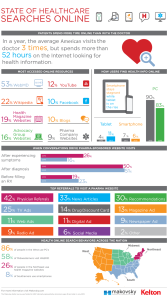 In game-scoring unit terms, 52 is the number of hours an average American spends seeking health information online each year. The 1 (hour) is roughly equivalent to the approximate total time a patient spends with a physician (an average of 3 visits, with an average time per vision of 20 minutes). Thus, 52:1.
In game-scoring unit terms, 52 is the number of hours an average American spends seeking health information online each year. The 1 (hour) is roughly equivalent to the approximate total time a patient spends with a physician (an average of 3 visits, with an average time per vision of 20 minutes). Thus, 52:1.
This means that the average U.S. health consumer spends much more time DIYing her health using digital information resources than speaking face-to-face with their physician in the doctor’s office.
Still, the physician continues to be a go-to source for health information, according to Makovsky, a health communications firm, and Kelton, the market research company, who summarized their latest survey into consumers’ digital health habits in Online Health Research Eclipsing Patient-Doctor Conversations published in September 2013. One-half of U.S. adults visited a pharmaceutical-sponsored website once receiving a diagnosis from a physician.
Along with physicians, there’s another source of health information people are increasingly turning to: online sites where they meet up with other patients, peers and advocates. 1 in 4 health consumers uses one or more social media channels for accessing health information – whether health care patient blogs, Facebook, Twitter, YouTube or other available portals where patient-peers come together.
When people go online seeking health information, they’re still using personal computers more than any other technology platform. But, the prevalence of PCs for search is declining as tablets are increasingly accessed for health searching. In 2013, 83% of health searchers use a PC, compared with 11% using a tablet and 6% using a smartphone. Note, however, that the use of tablets grew from 7% in 2012, and phones for mobile health search stayed flat over the year.
What U.S. adults didn’t search much was information on the Affordable Care Act (ACA) or health reform. Only 1 in 3 U.S. adults over 18 spent more than an hour researching the ACA online, and another third has never done so. 15% of hard-core health reform keen consumers spent at least 6 hours researching health reform via the internet.
Makovsky and Kelton interviewed 1,067 U.S. adults over 18 years of age in July 2013.
Health Populi’s Hot Points: The mainstream U.S. adult, well beyond the tipping point, is spending a lot of time throughout the year seeking health information online – on average, about an hour a week. Time with a doctor? An hour a year.
That 52:1 ratio of hours spent on health, outside of the doctor’s office vs. inside, begs the question: what to do in the interstices of time to enhance peoples’ health and experience with the health care system? The answer is in the cloud and mobile technology platforms, combined with the already-well-used internet. People are maturing in their use of the internet for health, with over 1 in 4 adults (per this survey) moving beyond Web 1.0 into 2.0 blogs, wikis, and social networks of peer-to-peer support and the Wisdom of Patients kicking in. (Other surveys show an even greater proportion of U.S. adults using social networks in health, as high as 40%).
Once again, this survey confirms what’s continued to be true for at least the 20+ years I’ve been advising the health industry: that physicians are (still) highly trusted channels of information. In this moment in health policy history, doctors can leverage their very scarce time through:
- Adopting telehealth technology (from emailing with patients to “safe Skyping,” undertaking virtual group visits);
- Fully utilizing electronic health records (EHRs) with patient portals (to be evangelized and supported by folks working in the medical practice); and,
- Prescribing mobile apps that can help patients bolster their health and better manage chronic conditions (think: medication adherence for cholesterol management and Wi-Fi enabled scales to stem hospital readmissions for congestive heart failure).
It’s a matter of scale and reach: with patients already in DIY health mode – that is, health care self-service – doctors can help patients optimize self-care through extending their touch and reach through technology platforms and tools that patients are already using – apart from their physicians.




 Thanks to Feedspot for naming this blog, Health Populi, as a
Thanks to Feedspot for naming this blog, Health Populi, as a